There’s more than one way to skin a cat and there’s certainly more than one way to educate a child – and there are huge benefits of homeschooling for traveling families no matter how you do it. We are not professional educators, so the timing of our family gap year was in part motivated by feeling that we could handle Jacob’s kindergarten homeschool needs better than subsequent grades. We’ve now been homeschooling/roadschooling/worldschooling for almost the entire school year and have gleaned so much about what works for him as a learner and for us as parents. Read on to find our kindergarten homeschool curriculum (such as it is) and our successes and failures in homeschooling while traveling.
Kindergarten homeschooling curriculum goals for traveling families
Our primary concern in crafting our kindergarten homeschool curriculum was readiness for 1st grade in a traditional school in the US. While nothing is set in stone as of this writing, that has seemed like the most probable next step for our family and we wanted to assure him a smooth educational transition. As such, we focused our roadschooling efforts on the cumulative core subjects: reading, writing and math. For all other subjects, we assumed that our worldschooling adventures as we travel the world for a year would expand his young mind more than any classroom experience could. For context, our son attended preschool for several years before our family gap year including pre-k.
Reading
Our goals for reading were the same as for any kindergarten curriculum. We want our child to read age-appropriate books with fluency and joy. There are so many great resources available, which we’ll share below, that helped us quickly get Jacob from letter recognition to fully reading. A further goal was to work on reading comprehension skills.
Writing
At the start of our family travelling around the world, Jacob could recognize all of the letters but couldn’t necessarily write them well. Our curriculum goals were to improve handwriting and eventually get him writing independently (and with some depth) about his experiences. We hoped that he would enjoy documenting a kid’s world travel experience.
Math
We didn’t establish a fixed math curriculum goal, but assumed that by the end of kindergarten he should be able to add and subtract two digit numbers, tell time and count out payments and change. When you’re homeschooling while traveling the world, so many of these skills come into play in daily life!
Science
If I had to label our science kindergarten homeschool curriculum, perhaps I’d call it “understanding the world around us”. Kindergarteners have a natural curiosity about animals around the world and their habitats, so we planned to lean into that to also teach the kids about climate change, geology and more.
Social studies
Let’s be honest: worldschooling is the best social studies education money can buy. We didn’t have a fixed plan (perhaps this qualifies as “unschooling”?) but relied on exposing the kids to various histories, cultures, languages and more as we traveled across so many countries and continents.
Art
Just like in traditional school, art is an important part of any curriculum. Our goal was just to encourage continued creativity. Jacob’s preferred medium is watercolor paint, so we brought his travel painting kit and watercolor book along with colored pencils.
Seven months in: our favorite kindergarten resources for homeschooling while traveling
BOB Books
My sister-in-law gave us her kids’ old BOB Books for our roadtrip and I quickly understood why! These books are absolutely perfect for beginning readers, with lots of repetition and slowly increasing length and difficulty. There are five sets in all, and we ended up purchasing most of them on Amazon since we didn’t want to drag the physical copies with us. I’d say that the first few sets of BOB Books are equivalent to the more common level 1 and early level 2 readers, though their sequential, cumulative nature makes them better for instruction. The fourth and fifth sets get rather complicated and long, more in line with harder level 2 readers and early level 3 readers. I initially thought that the illustrations and storylines wouldn’t be compelling to our very 21st-century child, but he stuck with them and really appreciated the sense of accomplishment he felt every time he finished reading a book. These were our favorite tools as traveling homeschoolers! Get your own set here.
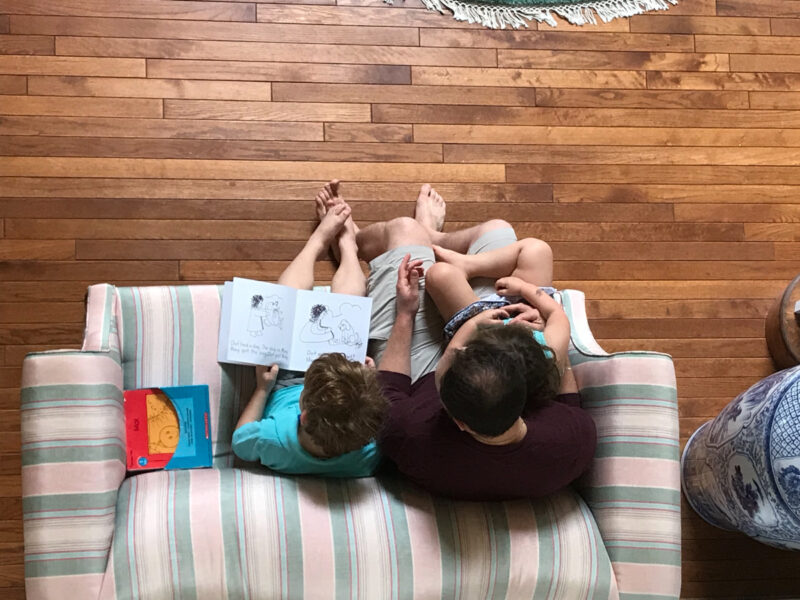
There are a variety of resources available for readers of all levels:
“Step into reading” books
For kids who have gone through at least the first few sets of BOB Books and have a solid foundation, the ubiquitous “step into reading” series is a great next step. We love that they have content that young kids know and love, including lots of Disney/Marvel tie-ins (see the full list here). There’s a decent amount of variation between books that are supposedly the same level, but any reading is good practice! Nearing the end of kindergarten, level 3 works well for Jacob. We always keep his Amazon Fire tablet stocked with a few options – check prices here. He has read too many of these to count, so here are a few favorites at each level:
Check out these sight word activities to help your kindergartener along!
Kindergarten workbooks
I know workbooks seem woefully out-of-date, and we were shocked and how well they worked for our family. We really appreciate the structure and sequencing, and the old-school pencil-and-paper methods worked well for Jacob compared to learning apps (more on those below in our “fails”). We found a workbook especially indispensable for working through letter formation, which he hadn’t learned well enough during pre-k. We bought workbooks in New Zealand and I literally bought the only relevant ones the discount store had for the subjects we needed (despite the stated age ranges not necessarily matching). The plan worked.
It is easy for us to assign a few pages of each subject for each day and we receive almost no push-back. Depending on the topic (new or review) we can decide how hands-on we need to be during each day’s session. They’re also great while we’re traveling so much, as we can do school work on planes and trains even without an internet connection. We restocked our workbook selection in Australia and will continue using them going forward until the next school year begins (and surely in future summers).
Amazon now carries the series we purchased in New Zealand, and we definitely recommend them! The graphics aren’t as important to us and the relatively low density – we did see some other choices that looked like they would overwhelm a young learner. We also prefer single-subject books for a few reasons: they’re lighter, and we can tailor the level to our child’s needs. He was simultaneously working through a handwriting book for ages 4-6 and a math workbook for ages 7-9! Note: my mom taught handwriting for years and STRONGLY recommends this book.
A word to the wise: pick up a good pack of mechanical pencils, lead and eraser refills… we spent the first few months constantly sharpening and re-sharpening low-quality novelty pencils, but finally picked up this set. And don’t forget the stickers for positive reinforcement! Here are some similar kindergarten workbooks available in the US:
Wild Kratts videos
PBS Kids Wild Kratts videos are some of the best TV shows for kids available today! The hosts, Chris and Martin Kratt, focus on one animal in each episode. Kids learn facts about the animals, but also about their habitats, threats and neighboring animals. So many times during our trip we have prepared for an animal encounter and the kids have already known more about the animals than we do! They have especially great coverage for Australian animals and various sea creatures. You can access some episodes of Wild Kratts for free with your Amazon Prime membership, or get all of PBS Kids through the new Amazon Channels service (try it free here).
Check out this science experiment you can do at home to learn about density!
Race the Wild book series
We spent a ton of time driving around New Zealand and Australia and wanted to avoid the kids being on their tablets all the time and hoped to inspire their sense of adventure. We decided that some read-aloud books would be a great choice, and to get us geared up for the region we picked Scholastic’s Race the Wild chapter book series (probably good for 2nd grade and up to read independently). The six books follow young Team Red as they compete to win a game show focused on both outdoor adventure and wildlife knowledge. They visit the Amazon rainforest, the Great Barrier Reef, Alaska, the African Savannah, the Australian Outback and even Nepal! Each chapter ends with either a “creature feature” or another fact-filled section about the local habitat, but learning is also integrated non-intrusively into the main text. If there were more books in the series, the kids would have been happy to continue reading them together.
Other travel books for kids
We’ve tried to read the kids books related to some of the places we’ve been visiting. Aside from the Race the Wild series above, we found some great kids books to get our children in the mood for some of our destinations:
LEGO
Hear me out: LEGO has to be one of the best teaching tools in our arsenal. There have been plenty of days when the kids spent HOURS working on their creations (since we’re pretty laid back when it comes to site seeing… and waking up early). The ubiquitous and sharp-underfoot bricks help them develop great engineering and spatial reasoning skills and get the creative juices flowing when it comes to the building process and how they play with the fruits of their labor. There’s a lot of storytelling that goes on, especially with favorite themes like Ninjago and Friends. The kids seem to like those sets best because they provide more unique pieces and stronger character associations than either the plain “box of bricks” or City sets. How much LEGO are we dragging around the world? It’s almost embarrassing. Roughly one gallon in a ZipLock bag, weighing in at close to 2kg (what’s that about traveling light?). And they even received a few more very small sets over the holidays! If you want to keep your LEGO lovers happy on a long trip, sneak some of these tiny sets in the bottom of your backpack to dole out along the way. Shockingly, there are days when the two kids are both building and they seem a little low on bricks… and then there are days when we feel like we need one of these.
Your kid isn’t into LEGO? Check out these other great enriching hobbies that will grow their young minds.
Hands-on experiences and conversations
There’s not a good way to quantify this one, but getting out into the world to see different people, places and foods up close has been one of our most valuable teaching tools. Travel is an amazing educator! This part of our family’s curriculum falls under the “unschooling” model. The kids have met many people from indigenous communities around the world, and we’ve followed it up with discussions of European colonialism and the challenges facing those communities today. They’ve seen first-hand the impact of anthropogenic climate change on glaciers in New Zealand and on the Great Barrier Reef. We talked about military juntas in South America and Buddhism in Thailand. They’ve seen endangered animals in remote wildlife sanctuaries. We go on regular hikes to learn about different plant and animal life and how the earth can provide natural resources if we take care – and also just to appreciate nature’s beauty without commentary. There are so many aspects of the world that don’t resonate with kids unless you’re in the place. While we’re sure some of the details have gotten lost over so much travel, the broad strokes remain and will be a good starting place for future conversations.
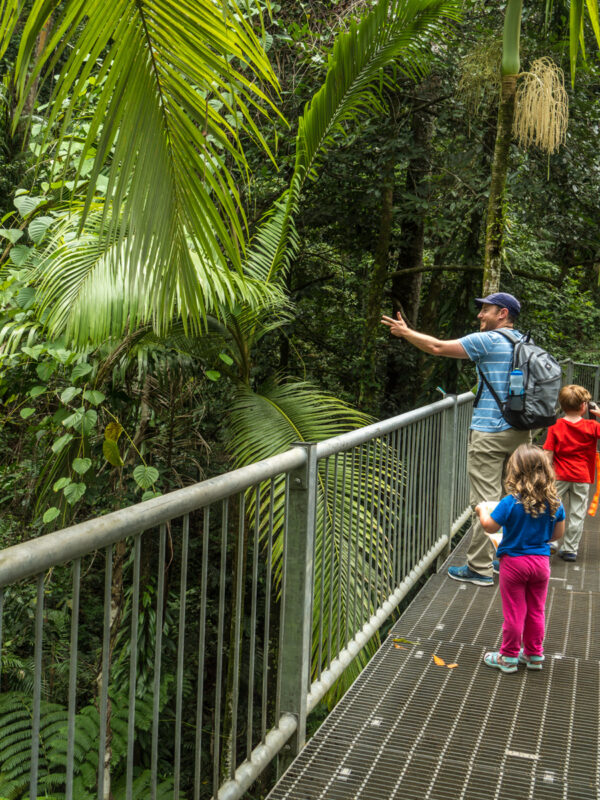
Our worldschooling fails
We tried a few things that didn’t work for our family! They may work great for other families, but we tried them and Jacob just wasn’t in a space to learn from them in the way we wanted. One of the huge benefits of homeschooling and worldschooling is that you can adjust your approach based on how your own child is responding, because we all know that kids are different!
Travel journal
This was our most disappointing fail! We tried from the outset to take a less formal approach to writing with Jacob by having him keep a travel journal. A great idea I read for kids his age was for the initial journal entry to be written by me (with him dictating) and for him to then hand-copy an increasing number of lines. We did it some, but it was like pulling teeth. We realize now that we were putting the cart before the horse – the kid was struggling to write individual letters, but we were asking him to write paragraphs! The dictation element worked fine and helped him work on his storytelling skills. Now that writing is less of a struggle, we may revisit the travel journal idea as we know that daily writing is part of many primary school curricula today.
Check out this cool downloadable kids travel journal!
ABC Mouse review
The popular online learning website ABCMouse.com places ads everywhere and it seemed like it was worth a try – it offers activities for preschool through early primary school, so both kids would be able to take advantage of its offerings and families have the option to either follow the set “learning path” or choose activities based on their child’s needs. Kids earn tickets as a reward for completing each activity. First, what we like: ABCMouse does a good job of playing to different modalities of learning, with a combination of games, videos, stories and more to teach and reinforce each concept. Some of the activities are really very good for reinforcing concepts!
Unfortunately we now feel like the website has more shortcomings than advantages, and it’s been months since we’ve used it. Why? One of our biggest complaints, which we’ve heard voiced by other parents, is that the tickets begin to overwhelm the actual learning activities. We didn’t find a way to keep kids out of the section to buy junk with their tickets without sitting over their shoulders at every moment. Our other more serious gripe is that, while we paid extra for the assessment center, that tool was not at all integrated with the learning path! That’s just silly. The early stages of the kindergarten learning path had topics like letter identification that also appeared on the learning path for our 3yo. One of the benefits of homeschooling is the ability to follow each child’s individual pace, but that isn’t possible on ABC Mouse. We’d love to see tighter integration between the assessment center and the learning path, and even the ability to skip learning path modules with the parent password.
Our other challenge was that there’s virtually no functionality available without an internet connection, even if you’ve downloaded the app – not ideal for a family travelling around the world. The only available module is letter bubbles, which isn’t very helpful for a child working his way through chapter books. Sometimes the app didn’t work even with WiFi.
We actually preferred the preschool curriculum offered in ABC Mouse. It goes through all of the building blocks with lots of different activities to reinforce concepts like letter recognition and counting. Check out a free trial of ABC Mouse today to see if it’s a good tool for your family.
How we fit homeschooling into our family travel schedule
Every family integrates schooling into their travel schedule differently, and we constantly change things depending on what country we’re in and how busy we are. As we’ve been traveling longer and slowed our pace of tourist activities, we’ve taken to doing schoolwork in the morning before going out for the day. Our schedule in Argentina was jam-packed, but the flights every few days provided a good distraction-free environment to work on reading. In New Zealand and Australia, where the massive cost of food kept us eating at home most nights, schoolwork fit in nicely during dinner prep. In northern Thailand, where we had lots of early morning activities planned to beat the heat, we’d spend some time before dinner cleaning up, relaxing and doing some work (school for the kids, writing for me!).
Staying organized is always one of the biggest challenges, whether you’re worldschooling or working an office job. Check out these awesome planners to help mom and the rest of the family stay organized.
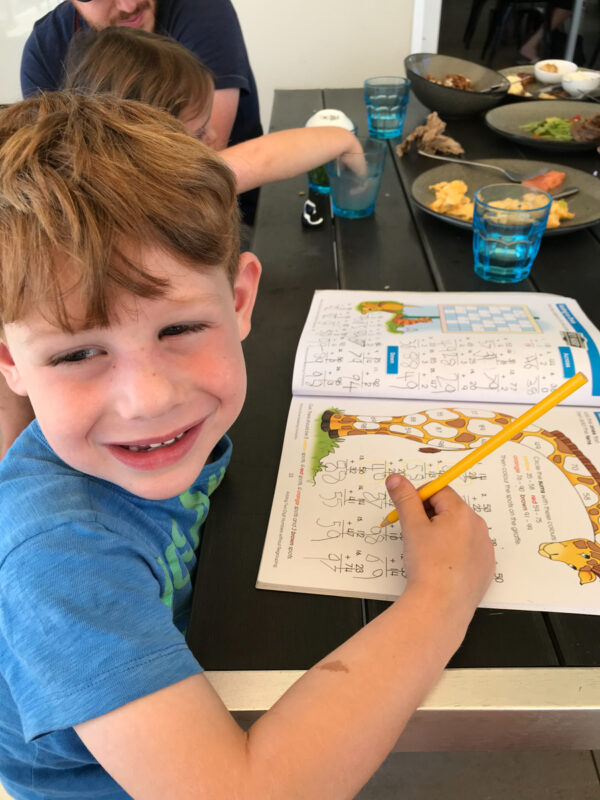
So how long do we spend on school work? Some days we spend an hour on Jacob’s core subjects and some days none at all. We probably average thirty minutes per day on formal workbooks and reading practice, but immeasurably more time on informal education! We practice reading menus in restaurants. We learn history and see culture as we stroll through a city. In that sense, you could consider that we average a solid six hours per day on educational ventures.
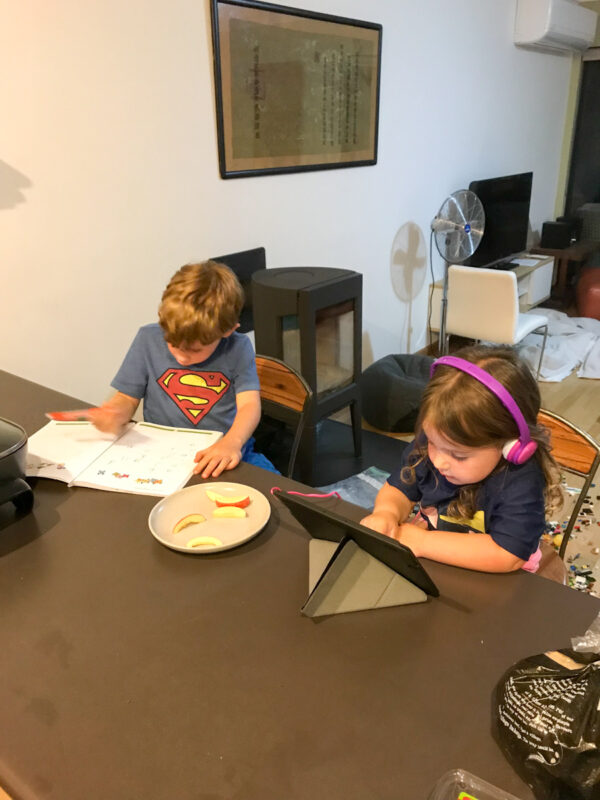
Practical tips for roadschooling
-Document your kid’s work! If you’re using workbooks, that’s obviously easy to manage. We sent some back to the US already and will probably send back more as we go to continue lightening our load. Documentation is important if you plan to re-enroll your child in a traditional school in the future.
-Find a teacher to talk with now and then if you have questions. I’m lucky to have connected with a primary school teacher online, and she’s been helpful when I’ve had questions about how to approach certain topics and making sure we’re on the right track.
-Read the mood and don’t feel constrained by the “regular” school schedule. There are days when I can tell that it’s going to be a really productive session and we’ll get through a ton of material. And there are days when that’s not going to happen, so we just go through the minimum we need to do to keep momentum and make sure the material stays fresh. We love having the flexibility to roll with the punches, and we fully expect to continue learning at some pace even through the summer. So we may cover some material like writing more slowly, but we’ll keep going right up until the start of the next school year.
-Adapt to fit the location. After all, travel is the best teacher! We didn’t talk about science at all in northern Chile, but spent a lot of time on 20th century history. We flipped when we got to southern Chile and learned about volcanic and geothermal activity.

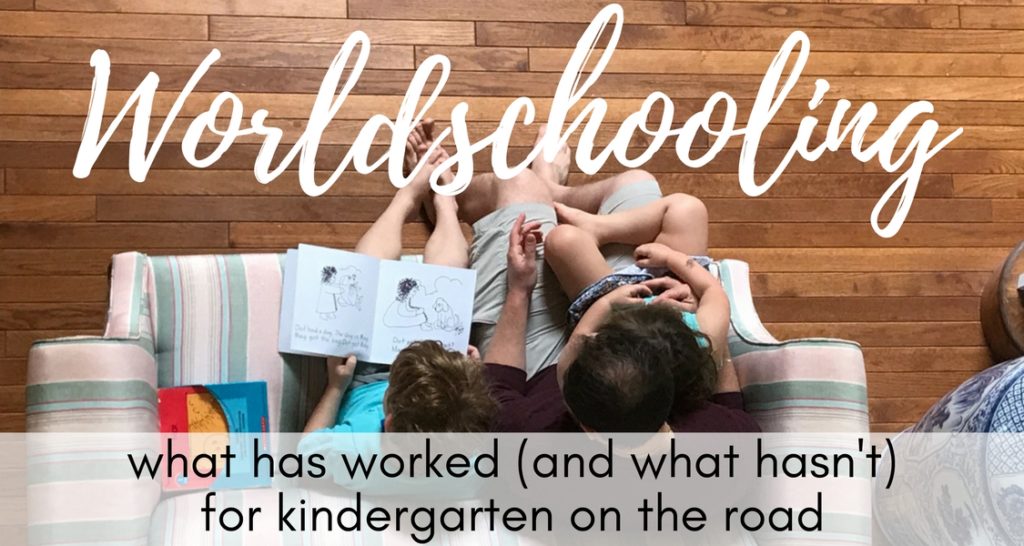
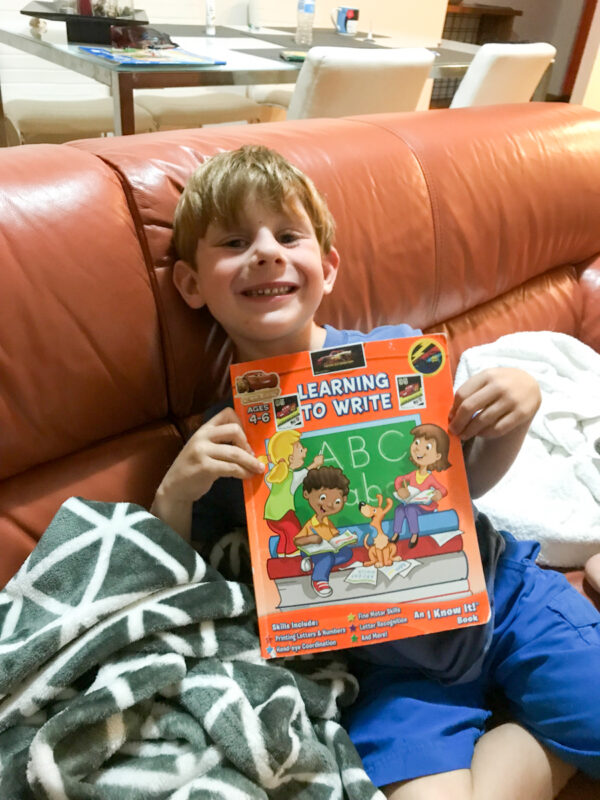
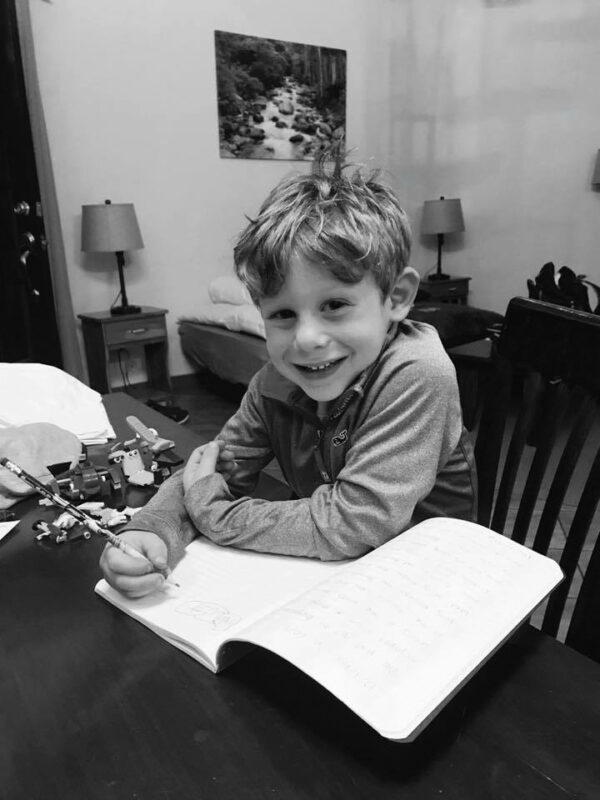
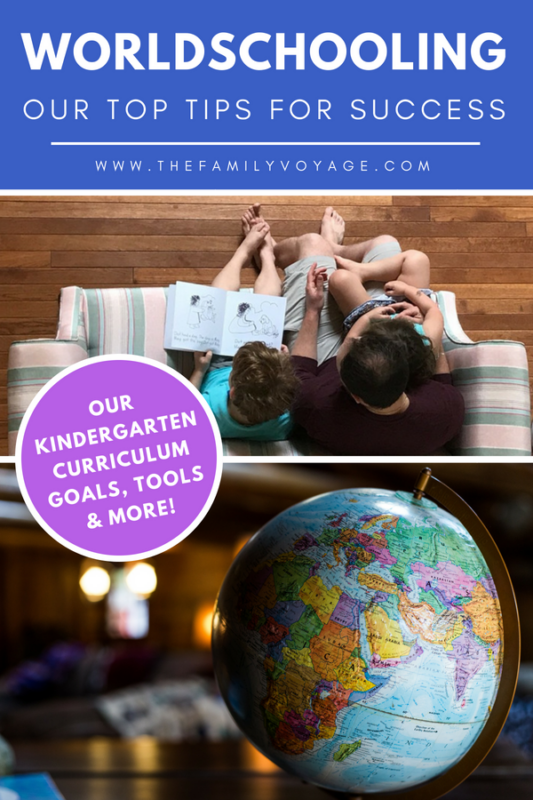
Wow — I didn’t read carefully enough the first time to realize that we’re actually REALLY similar in the books we’ve chosen! Norah’s first readers were the BOB books 😉 (Of course, they made me want to stab my eyes out, but … all’s well that ends well, I guess?) I’ve gotten her one of the “Ride the Wild” books for when we’re in Costa Rica this summer — the Amazon one, but I figure it’s probably about the same and if it’s a good book, at the right level, it’s probably a win! And I just bought some of the math workbooks you recommended. Thanks!!!
We failed at the travel journal too … just getting him to draw a picture was like pulling teeth! Will try again next trip! It worked easier when I was able to work one-on-one with him, but with a 4 year old at my side constantly, my 6 year olds concentration was with what his brother was playing with!
Glad we’re not alone!!! It’s a nice idea ?
What a great post! My husband and I have been deciding on the when, where, and how for our year abroad. My daughter will be kindergarten age and my son 3 when we set off. The information in this post is incredibly helpful for me see what homeschooling while traveling abroad might look like. As a seasoned traveler, I agree that there the world is the best classroom! Thanks for sharing your experience.
My pleasure! Hit me up if you ever have any questions 😊